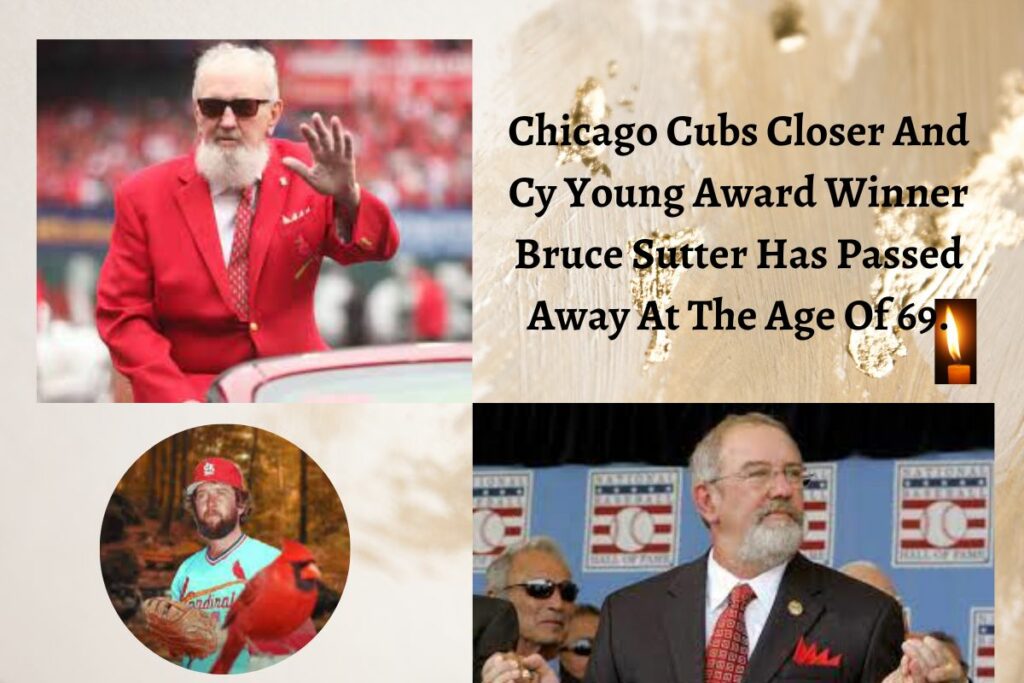SAINT-LOUIS — Bruce Sutter didn’t set out to find a way to Cooperstown when he started tinkering with the split-fingered fastball. All he wanted to do was keep his job.
Before being inducted into the Hall of Fame in 2006, Sutter said, “I wouldn’t be here without that pitch.” My other work was, at most, double-A quality. The middle finger split it in half, and now we’re even.
Known for developing the sharp-dropping pitch that would come to dominate big-league hitters for decades, Sutter, the bearded closer who paid for his elbow surgery as a low minor-leaguer, passed away on Thursday. He was 69.
You can also check
- Nikki Finke Cause Of Death: Veteran Journalist Passes Away At 68
- Mike Schank Cause Of Death: American Movie Star Death Explored
Chad Sutter, one of Sutter’s three sons, revealed to the Associated Press that their father had recently been diagnosed with cancer and was in hospice care. Bruce Sutter passed away on April 5 in Cartersville, Georgia, according to the Baseball Hall of Fame.
For five consecutive seasons, Sutter topped the National League in saves, and in 1979, he was named the league’s most valuable player. In his twelve years of MLB play, he recorded 300 saves for the Chicago Cubs, St. Louis Cardinals, and Atlanta Braves.
When Sutter was active, closers frequently recorded four or more outs. For 188 of his saves, he threw multiple innings, and five times he threw over 100 innings in a season.
To cap off the Cardinals’ Game 7 win over the Milwaukee Brewers in the 1982 World Series, he threw two perfect innings, retiring future Hall of Famers Paul Molitor, Robin Yount, and Ted Simmons.
Commissioner Rob Manfred of #HOF closer and #stlcards great Bruce Sutter. pic.twitter.com/jEzf4t6nx7
— Derrick Goold (@dgoold) October 14, 2022
According to his son, Sutter placed the utmost importance on the team’s successes. All that mattered to him was victory and earning the respect of his teammates and opponents alike, so he never hung up any of the trophies he had won. His entire drive came from that, he said in a phone interview with the AP on Friday.
After his retirement, when he started receiving awards, he thought to himself, “Man, I did OK, you know?” What mattered most to him was his role as a teammate.
After Hoyt Wilhelm, Rollie Fingers, and Dennis Eckersley, Sutter became only the fourth reliever to be inducted into the Hall of Fame. Later additions include Mariano Rivera, Goose Gossage, Lee Smith, and Trevor Hoffman.
Braves manager Brian Snitker lamented, “We lost a good friend in Bruce Sutter last night,” before Friday’s NL Division Series game against the Phillies in Philadelphia.
Rob Manfred, the commissioner of Major League Baseball, expressed his “deep sadness” over the development.
The Cubs mourn the passing of Hall of Fame pitcher Bruce Sutter.
The 1979 NL Cy Young Award winner and a member of the Cubs Hall of Fame, Sutter pitched with Chicago from 1976-80, collecting 133 saves, second-most in franchise history.
Deepest sympathy to the Sutter family. 💙 pic.twitter.com/WHzzNFGzaV
— Chicago Cubs (@Cubs) October 14, 2022
“Bruce was the first pitcher to reach the Hall of Fame without starting a game, and he was one of the key figures who foreshadowed how the use of relievers would evolve,” Manfred said. Bruce, you will go down in history as a great pitcher for two of our most storied teams.
Sutter entered this world in 1953. While the Washington Senators selected him in the 21st round of the 1970 MLB draught, he was still too young to sign.
He attended Old Dominion University for only a semester before returning home to pitch for the semi-professional Hippey’s Raiders of the Lebanon Valley League, where he was discovered by a scout from the Chicago Cubs.
In 1972, while learning the slider for the Cubs, Sutter injured his right elbow and could only make two appearances for the team in the Gulf Coast League. Sutter scheduled surgery and used his bonus money to pay for the procedure out of fear that the Cubs would release him if they knew about his injury.
Sutter was fortunate enough to learn the split-fingered fastball from Cubs minor league pitching instructor Fred Martin during spring training in 1973, when he was unable to throw as hard as he had in the past.
A statement from the Sutter family on the passing of Hall of Famer Bruce Sutter: https://t.co/I8n7bGRtuo pic.twitter.com/n6ei2nARjJ
— Katie Woo (@katiejwoo) October 14, 2022
No one was throwing the “split-finger” that Sutter referred to. “It wasn’t a revolutionary pitch, but it did create a new way to get batters out,” said one baseball analyst. Since Fred Martin (who passed away in 1979) was the first to teach the split-fingered fastball, everyone who uses it owes him a debt of gratitude.
Former major leaguer Roger Craig popularised the pitch, in which the ball is held between the index and middle fingers and suddenly dips as it approaches the plate, but it wasn’t being thrown effectively.
It was simple for me to grasp in the beginning, but mastery required a lot of practise, as Sutter put it. I had some serious arm strength. There’s a chance I’ll strike out 16, but I could also walk 10. You could say I was a bit crazy.
Back in 1976, Sutter made his major league debut with the Cubs. In 1979, he had 37 saves, 2.22 ERA, and 110 strikeouts, and was named Cy Young Award winner. He spent five seasons in Chicago and posted a 32-30 record with a 2.30 ERA and 133 saves.
With an overall record of 68–71, Sutter had a 2.83 ERA in his career. Over the course of 661 games, he threw 1,042 innings and struck out 861 batters. From 1981 to 1984, he was a Cardinals’ pitcher.
The Sutter family released a statement on Friday saying, “Being a St. Louis Cardinal was an honour he cherished deeply.” We want to express our gratitude to everyone who has supported him over the years, especially the Cardinals, his teammates, and the best fans in sports.
Cardinals owner and CEO Bill DeWitt Jr. said, “Bruce was a fan favourite during his years in St. Louis and in the years that followed, and he will always be remembered for his 1982 World Series clinching save and signature split-fingered pitch.” He revolutionised the role of the late-inning reliever, earning the accolade “true pioneer in the game.”
It took MLB 42 years to retire Jackie Robinson’s number, but the Cardinals finally got around to retiring Sutter’s number this year. A statement released by the Cardinals states that Sutter is survived by his wife, three sons, a daughter-in-law, and six grandchildren.
You can also check
- Joyce Dahmer Cause Of Death: Information About Her Suicide Tried
- Sara Lee Wrestler Cause Of Death: Three Kids Now Motherless
‘All our father ever wanted to be remembered for was being a great teammate,’ the Sutter family said in a statement, ‘but he was so much more than that. He was a wonderful friend, a loving father and grandfather, and a devoted husband to our mother for 50 years. Although he is deeply devoted to baseball, nothing compares to his devotion to his loved ones.
It was said by Chad Sutter that his father “didn’t suffer and he went and went quick and he went peacefully, surrounded by all of his loved ones.” As far as the family is concerned, funeral arrangements are still in the works.
Hall of Fame pitcher Jim Kaat, who played with Sutter on the 1982 World Series champion Cardinals, said, “I feel like a brother passed away.” More than any other teammate, Bruce was someone I had spent significant time with. We worked closely together for many years, but as is customary when one’s working relationship comes to an end, we now find ourselves on different paths. Nevertheless, we kept in touch and became close friends.




